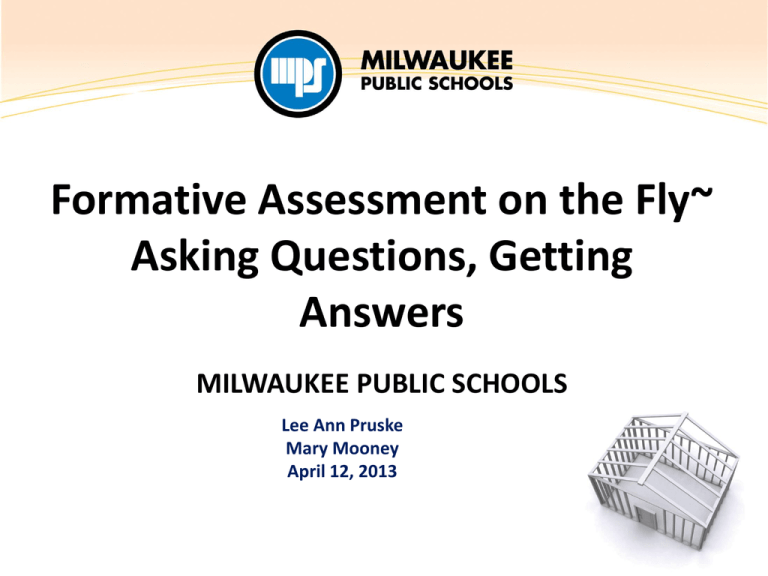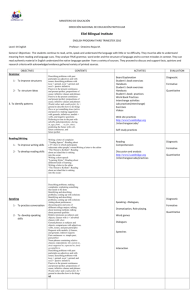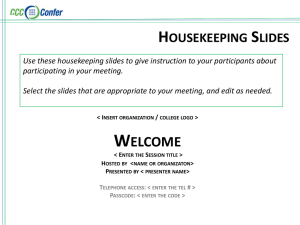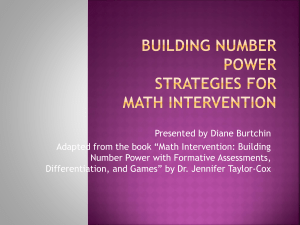PPT
advertisement

Formative Assessment on the Fly~ Asking Questions, Getting Answers MILWAUKEE PUBLIC SCHOOLS Lee Ann Pruske Mary Mooney April 12, 2013 Professional practice Work with one teacher on the formative assessment process. Elicit, interpret, make decisions about the next steps in instruction, and implement those decisions with students. Prepare a short vignette around the work with teachers and students to share at the April ACM meeting. Give One, Get One With your typed vignette in hand, find a partner . Share your stories, trade vignettes Find a new partner and share, trade vignettes Learning Intention Success Criteria We are learning to use the formative assessment process within the classroom DURING instruction. We will know we are successful when we recognize formative assessment opportunities in classrooms. “…it is essential that teachers explore students’ thinking before assuming that students have understood something.” D. Wiliam, 2011 Why ask questions? 1. Cause thinking 2. Provide teacher with information to assist instructional decision making* *Ask questions that students can’t get the correct answer with incorrect thinking. What is the purpose of the question? Discussion Questions Whole class discussion Surface student thinking, and justifications Teachers can probe for details Takes class time Diagnostic Questions Individual responses Discussion not needed Be careful students don’t get right answer, for incorrect thinking Misconception Managed Take a card out Individually solve the problem Discuss how you might surface student understanding through this problem Would you use the problem as a classroom discussion, or individual diagnostic tool Pass the envelope and repeat Problem A Simplify (if possible) 2a + 5b Problem B Make this true: 3a = 24 a + b = 16 Problem C Which is larger: 3/7 or 3/11 Problem D In this sequence 3, 7, 11, 15, 19 Which is the best rule to describe the sequence. a. n + 4 b. 3 + n c. 4n – 1 d. 4n + 3 Formative Assessment…on the fly Diagnostic Questions “Range-finding” questions find out what students already know before beginning a topic. “Hinge point” diagnostic questions are used in the middle of instruction to check for understanding. Next step hinges on student understanding. Types of Listening Evaluative listening Listening for knowledge, content, correctness. ○ (Do they get it?) ○ (Do I need to re-teach this content or can I move on?) Interpretive listening What are students’ thinking? ○ (How can I build on their understanding?) Shifting Up teacher moves Instructional Practice Skill Use your ABCDEF cards to answer Hold up the correct cards indicating your answer. No discussing please. In which of these right triangles does a2 + b2 = c2 A B C b a c a c b b D c E F c b a c a a b c b a What is the relationship among the sides of a right triangle? What is the relationship among the sides of a right triangle? c In which of these right triangles does a2 + b2 = c2 A B C b a c a c b b D c E F c b a c a a b c b a Instructional Strategy Revisited Diagnostic question All student response through A-F cards Interpretive listening Professional Practice Observe a teacher or two in your building listening for opportunities to work with student misconceptions. Type up what you observe and put it in the TLC under Listening Practice. Consider the following in your summary: Why did the student answer incorrectly? What is the misconception? Was the teacher engaged in evaluative or interpretive listening? How does/did the teacher plan for misconceptions? Did misconceptions derail instruction? What did the teacher do next? Post by May 10, 2013, Reply to at least 2 colleague’s posts by May 24, 2013 Feedback question What is your hunch about the types of questions (diagnostic, discussion, range finding, hinge point) teachers in your building will be asking when you listen in for misconceptions in math? Spring CR items are up! www.mmp.uwm.edu Instructional Guides Use them with your teachers. Milwaukee Public Schools TITLE OF PRESENTATION MPS Board of School Directors Senior Team Dr. Michael Bonds, President Larry Miller, Vice President Mark Sain, District 1 Jeff Spence, District 2 Annie Woodward, District 4 Dr. Peter Blewett, District 6 David Voeltner, District 7 Meagan Holman, District 8 Terrence Falk, At-Large Dr. Gregory Thornton, Superintendent Naomi Gubernick, Chief of Staff Darienne Driver, Chief Innovation Officer Tina Flood, Executive Director, Curriculum and Instruction Dr. Karen Jackson, Chief Human Resources Officer Michelle Nate, Chief Operations Officer Gerald Pace, Esq., Chief Financial Officer Anita Pietrykowski, Director, School Administration Denise Callaway, Communications & Partnerships Patricia Gill, Executive Director, Family Services Sue Saller, Coordinator to the Superintendent










